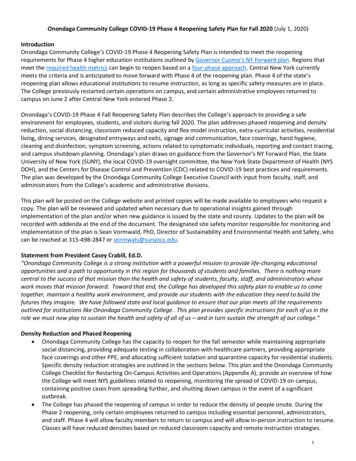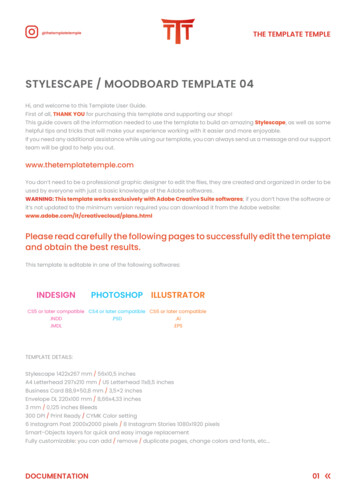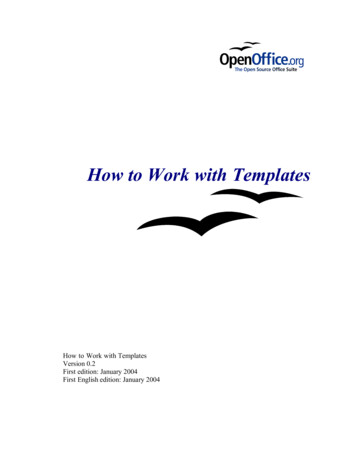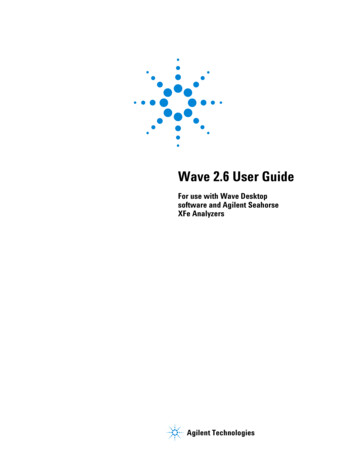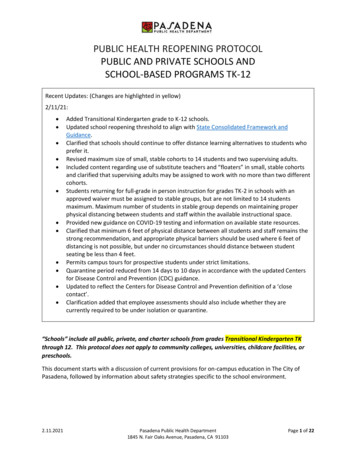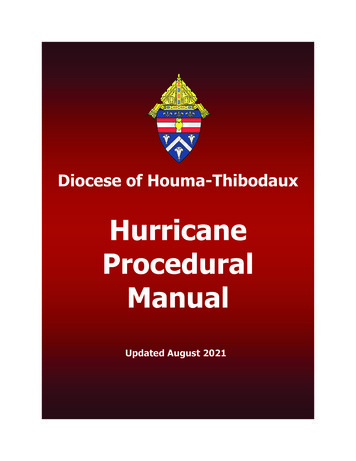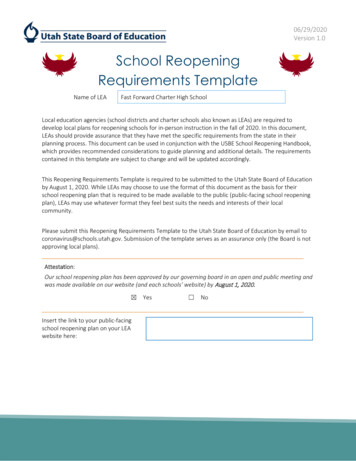
Transcription
06/29/2020Version 1.0School ReopeningRequirements TemplateName of LEAFast Forward Charter High SchoolLocal education agencies (school districts and charter schools also known as LEAs) are required todevelop local plans for reopening schools for in-person instruction in the fall of 2020. In this document,LEAs should provide assurance that they have met the specific requirements from the state in theirplanning process. This document can be used in conjunction with the USBE School Reopening Handbook,which provides recommended considerations to guide planning and additional details. The requirementscontained in this template are subject to change and will be updated accordingly.This Reopening Requirements Template is required to be submitted to the Utah State Board of Educationby August 1, 2020. While LEAs may choose to use the format of this document as the basis for theirschool reopening plan that is required to be made available to the public (public-facing school reopeningplan), LEAs may use whatever format they feel best suits the needs and interests of their localcommunity.Please submit this Reopening Requirements Template to the Utah State Board of Education by email tocoronavirus@schools.utah.gov. Submission of the template serves as an assurance only (the Board is notapproving local plans).Attestation:Our school reopening plan has been approved by our governing board in an open and public meeting andwas made available on our website (and each schools’ website) by August 1, 2020. YesInsert the link to your public-facingschool reopening plan on your LEAwebsite here: No
Fast Forward Charter High School Reopening RequirementsContentsRepopulating Schools . 2Communication and Training . 2Accommodating Individual Circumstances (e.g., High-Risk, Personal Decisions) . 3Enhanced Environment Hygiene & Safety . 3School Schedules . 4Monitoring for Incidences . 4Containing Potential Outbreaks . 5Preparation Phase . 5Quarantine/Isolation Protocol . 5Temporarily Reclosing (if Necessary) . 6Preparation Phase . 6Transition Management Preparation . 6Mitigation Tactics for Specific School Settings . 8LEA Mitigation Strategies for Specific School Settings . 8Repopulating SchoolsCommunication and TrainingState Requirement (“What”)Develop administrator/teacher/staffeducation and training on school’sreopening protocol and action plans Educate and train studentsand caregivers on school’sprotocols and action plan;post and/or make accessibleto school communitiesMake materials available tofamilies in their respectivepreferred/primary languageAppoint a point of contact for eachschool available for questions orspecific concerns.Implementation Plan (“How”) Regularly communicate to staff, students, and families on bestpractices for at-home preventive care. Use a variety of audiences including email, voice messaging,website, social media, and print mailings. Evaluate, improve, and reevaluate school plans, as necessary. In consultation with local health, pre-write/draft statements forvarying situations regarding outbreaks, positives cases, etc. Train teachers and staff on new school protocols and cleaningprocedures.Indicate assurance: Yes No
Fast Forward Charter High School Reopening RequirementsAccommodating Individual Circumstances (e.g., High-Risk, Personal Decisions)State Requirement (“What”)Implementation Plan (“How”)Create a process forstudents/families and staff to identifyas high risk 1 for severe illness due toCOVID-19 and have a plan in place toaddress requests for alternativelearning arrangements, remotelearning or instruction, or work reassignments.Students or families that identify as high risk for severe illnesswill meet with the school counselor to setup online learninguntil the situation presents itself for their return to in-personlearning.Take reasonable steps to minimizeand mitigate risk for employees whoidentify as high risk.Employees who identify as high risk will communicate with theschool principal to create a plan to best protect theirwellbeing.Systematically review all currentplans (e.g., Individual HealthcarePlans, Individualized Education Plansor 504 plans) for accommodatingstudents with special healthcareneeds and update their care plans asneeded to decrease their risk forexposure to COVID-19.Indicate assurances: Yes NoEnhanced Environment Hygiene & SafetyState Requirement (“What”)Implementation Plan (“How”)Develop protocols for implementingan increased cleaning and hygieneregimen.Indicate assurance: Yes NoFaculty and staff wear face coverings(e.g., masks or shields) whenphysical distancing is not feasible1Faculty and staff will wear face coverings when physicaldistancing is not feasible. As well as, follow any protocol issuedHigh-risk individuals are defined as people 65 years and older, people who live in a nursing home or long-term carefacility, people of all ages with underlying medical conditions, including lung disease or moderate to severe asthma,people who have serious heart conditions, people who are immunocompromised (many conditions can cause aperson to be immunocompromised, including cancer treatment, smoking, bone marrow or organ transplantation,immune deficiencies, poorly controlled HIV or AIDS, and prolonged use of corticosteroids and other immuneweakening medications), people with severe obesity, diabetes, chronic kidney disease undergoing dialysis, or liverdisease.
Fast Forward Charter High School Reopening Requirementsby local health department, state health department, UtahState Board of Education, or Governor’s office.Make hand sanitizer, disinfectingwipes, soap and water, or similardisinfectant readily available tostaff/students/visitors in controlledenvironments to ensure safe use.Indicate assurance: Yes NoSchool SchedulesState Requirement (“What”)Implementation Plan (“How”)Due to the unique nature of schoolschedules, USBE has not providedstate-wide requirements.Students will be staggered throughout the day in an AM andPM schedules. This will allow for smaller class sizes and allowfor physical distancing.Monitoring for IncidencesState Requirement (“What”)Implementation Plan (“How”)Develop administrator/teacher/staffeducation and training on your LEA’sprotocol for symptom monitoring.At the beginning of the school year and throughout the schoolyear, faculty and staff will be trained in the new procedures thatstudents will be held to (temperature checks, etc.) and how toreport students with symptoms to the contact person.Establish a plan to assist families inconducting symptom checking athome. Create a pamphlet to educate parents on the at-homeexpectations for monitoring student health. Students who have to stay home due to illness or familycircumstances will be able to participate in their classesonline remotely. Attendance policy will be flexible to assist with students whoare unable to attend due to COVID-19 circumstances.Assist families in access tothermometers, or other items, asneeded to fulfill appropriatesymptom checking requirements.If parents or caregivers are unable to check symptoms, thenthey can request for the school to check the student’ssymptoms.Monitor staff/student symptoms andabsenteeism carefully.Indicate assurance:Educate and promote tostaff/students: “If you feel sick; stayhome” Yes NoIndicate assurance: Yes No
Fast Forward Charter High School Reopening RequirementsDo not allow symptomatic individualsto physically return to school unlesstheir symptoms are not due to acommunicable disease as confirmedby a medical provider.Indicate assurance: Yes NoContaining Potential OutbreaksPreparation PhaseState Requirement (“What”)Implementation Plan (“How”)Develop administrator/teacher/staffeducation and training on school’sprotocol for containing potentialoutbreaks. A quarantine area has been designated for students howshow symptoms. A general waiting area has been designated for limitedvisitors and students with unscheduled needs. Minor injuries and first aid will be taken care of in theclassroom rather than the main office.Consult with local health departmentregarding procedures for tracing apositive COVID-19 case by anemployee, student, visitor, or thosewho have come into contact with anindividual testing positive. Administration will use all tools at their disposal includingclassroom seating charts, video surveillance, andinterviews to identify individuals who may have come incontact with a positive individual.Quarantine/Isolation Protocol 2State Requirement (“What”)Implementation Plan (“How”)Designate quarantine rooms at eachschool to temporarily house studentswho are unable to return homeIndicate assurance:Communicate health and safetyissues transparently, while protectingthe privacy of students and families.2 Yes NoHealth and safety issues will be communicated with allstakeholders through all communication possible whilemaintaining privacy for the individual.“Quarantine” refers to the recommendations regarding someone that has been exposed to virus (but not yet aconfirmed case) is recommended to separate oneself while waiting to see if symptoms develop. “Isolation” refers tothe recommendations regarding someone who has a confirmed infection.
Fast Forward Charter High School Reopening RequirementsTemporarily Reclosing (if Necessary)Preparation PhaseState Requirement (“What”)Implementation Plan (“How”)Develop administrator/teacher/staffeducation and training on school’sprotocol for temporarily reclosingschools if necessary. Administration/teachers/staff will be trained during the firstof year PD with on-going throughout the school year. Teachers will also receive training on the expectations forcontinuing education during the closure(s).Establish a plan in consultation withlocal health on responding toconfirmed cases and the coordinationof temporary closure of a school. Bear River Health Dept. (BRHD) will be consulted with toimplement best practices and procedures for the closureand reopening of the school.In the event of an outbreak, contactthe local health department in orderto trigger the pre-established planwhich may include: class dismissal,school dismissal, longevity ofdismissal based on communityspread, cleaning/sanitization,communications, contact tracing, etc. BRHD will be notified if any student or family has beeninfected and a plan will be developed immediately withactions following the examples in the “State Requirement”section.Transition Management PreparationState Requirement (“What”)Develop a communication procedurefor students and faculty in the casethere is a temporary reclosure.Implementation Plan (“How”) All forms of communication will be utilized (phone, email,text, social media, etc.) to inform all stakeholders of atemporary outbreak.Review original Continuity ofEducation Plans that wereimplemented during the spring 2020soft closure and analyze lessonslearned. Consider making changesaccordingly and incorporating intotransition management plans.Indicate assurance:Analyze remote learning capabilities.Indicate assurance: Yes No Yes NoExplore extracurriculars/in-personevents that may also need to be All large gatherings (50 ) will be cancelled until further noticeor based upon the recommendations from the Governor’soffice, USBE, or BRHD.
Fast Forward Charter High School Reopening Requirementstemporarily postponed/canceled ortransitioned to virtual.
K-12 Reopening Plan AssurancesMitigation Tactics for Specific School SettingsLEA Mitigation Strategies for Specific School SettingsAnalyze each of the following settings to determine the appropriate risk mitigation strategies to implement. By analyzing the environmental features of your unique setting/activity, you can use what you know about how the virus works and how itspreads to develop a plan for additional strategies. For complete directions on how to fill out the chart, see the USBE School Reopening Handbook. The state requirements have been included in the chart in purple, bold font. If a certain staterequirement prompts you to develop a protocol or strategy, describe your planned approach within the appropriate table cell. You can also reference the Handbook for additional recommended considerations specific to each school setting. Addadditional mitigation strategies to each school setting as you see fit. You may also add additional rows for other school settings that your LEA would like to address.Mitigation TacticsSettingState Requirement(s)Isolate Symptoms(e.g., contact tracing, testing, symptommonitoring, self-isolation, etc.)Classrooms-Develop and provide educatortraining on implementingstrategies to identify and mitigaterisk in a classroom setting---Transitions-Identify high traffic areas andapply floor markings or signage todirect traffic--Minimize Outbreak Probability(e.g., group size, interaction with multiplegroups, etc.)Teachers will have strict assignedseat policies to ensure that contacttracing is possible.Teachers will monitor student’sappearance and ask foradministration/nurse assistance inassessing the well-being of astudent.Thermometer checks will be usedif deemed necessary byadministration.-Video surveillance will be utilizedfor contact tracing during classtransitions that occur in thehallway.Hallways will be one way.-Class size has been reduced to10-12 students based on theroom sizes.Physical Distancing(e.g., maintaining distance, close physicalinteraction, frequency of travel, etc.)-Desks will be placed 6 feetapart within the classroom.PE courses will utilize the gymand outdoor field to maximizedistancing during highrespiratory output.Respiratory HygienePhysical Hygiene(e.g., face coverings, appropriate coveringof sneeze/cough, reduce duration spentface-to-face, increase air flow, etc.)(e.g., personal hygiene, physical spacehygiene, personal protective equipment,etc.)---Students will all be released atthe same time; however, therewill be minimal time in thehallway with only 2 minutes ofpassing period.All teachers will be in thedoorway to monitor studentbehavior.-Hallways will be one way.--Face coverings will be utilizedbased on therecommendations of theGovernor’s office, USBE, andBRHD.Students will sit not facingeach other.Students will also beeducated on the appropriateetiquette of sneezing andcoughing.-Face coverings will be utilizedbased on therecommendations of theGovernor’s office, USBE, andBRHD.Teachers will wear facecoverings while standing atthe door during passingperiod.---The last five minutes ofeach class will be spentcleaning the student desksand surrounding areas.Teachers will be trained onthe appropriate cleaningmeasure for theirclassroom.Classroom teachers willhave hand sanitizeravailable.Hallways will be swept, andlockers sanitized after eachpassing period.8
K-12 Reopening Plan AssurancesMitigation TacticsSettingState Requirement(s)Isolate Symptoms(e.g., contact tracing, testing, symptommonitoring, self-isolation, ---Establish protocols for any visitorsand non-regular staff, including at aminimum temperature checkingand the wearing of face coveringsEstablish protocols for dropoff/pick-up and communicateupdates and expectations tofamiliesLimit nonessential visitors andvolunteers to campuses andprograms; each school is todetermine essential versusnonessentialDesignate entry/exit flow paths tominimize congestion-Develop protocols for minimizingmixing of students from differenthouseholds and regularly cleaningand disinfecting seats and otherhigh-touch surfacesImplement strategies to ensuredriver safetyFace coverings for students, staff,other passengers; LEAs may makeexceptions for unique studentcircumstances-Provide education and displaysignage on proper hand hygieneCreate schedule for cleaning hightouch areas (e.g., faucets, papertowel dispensers, door handles)Ensure PPE (gloves, masks) isavailable for staff providingsupport in restrooms, includingcustodiansProvide training for propercleaning protocols for COVID-19Video surveillance will be utilizedfor contact tracing during classtransitions that occur in thehallway.Minimize Outbreak Probability(e.g., group size, interaction with multiplegroups, etc.)-Fast Forward will limitnonessential visitors andvolunteers.Physical Distancing(e.g., maintaining distance, close physicalinteraction, frequency of travel, etc.)----Students who ride the CVTD toFast Forward will follow theguidelines laid out by thecompany.Physical Hygiene(e.g., face coverings, appropriate coveringof sneeze/cough, reduce duration spentface-to-face, increase air flow, etc.)(e.g., personal hygiene, physical spacehygiene, personal protective equipment,etc.)Signage will be posted toencourage physical distancing.There will be only one entryand exit used within theschool.All entrances and exits will beused to avoid clustering atsingle points of entry.--Students who ride the CVTD toFast Forward will follow theguidelines laid out by thecompany.--No more than two studentswill be allowed into abathroom at a time.Signage will be postedinforming the students.---Students who ride the CVTD toFast Forward will follow theguidelines laid out by thecompany.Respiratory Hygiene--Face coverings will be utilizedbased on therecommendations of theGovernor’s office, USBE, andBRHD.All visitors will be required toa temperature check andwear a face covering duringtheir visit at Fast Forward.-Hand sanitizer will beavailable upon entry/exit tothe school.Students who ride the CVTDto Fast Forward will followthe guidelines laid out by thecompany.-Students who ride the CVTDto Fast Forward will followthe guidelines laid out bythe company.-Custodians will disinfect andrestock restrooms twice aday.9
K-12 Reopening Plan AssurancesMitigation TacticsSettingState Requirement(s)Isolate Symptoms(e.g., contact tracing, testing, symptommonitoring, self-isolation, etc.)-Cafeterias---Large GroupGatherings (e.g.assemblies,performances)Unique Courseswith HigherRisk of Spread-Mark spaced lines and designateserving line flow pathsRemove self-service salad bars andbuffetStudent hand hygiene routines(i.e., hand washing or sanitizer)before and after meal servicesIncrease cleaning and disinfectingof high-touch areas-Ensure group gatherings areorganized with health and safetyprinciples and requirements inplace and, as needed, inconsultation with local healthdepartments-Identify courses that would bemore at risk and make plans withsupport from local healthdepartments (as needed) tomitigate the risks.--Video surveillance will be utilizedfor contact tracing during lunch.There will be only one entry andexit used within the cafeteria.Minimize Outbreak Probability(e.g., group size, interaction with multiplegroups, etc.)-Video surveillance will be utilizedfor contact tracing during largegatherings.-Courses with high risk of spreadwill be identified and students andfamilies will be informed of the riskprior to or upon registering for thecourse.--Tables will have plexiglassdividers for the individuals atthe table and tables will beplaced 6 feet from each other.Schools will limit or cancelnonessential gatherings.Mitigation strategies will beused for safety drills.Physical Distancing(e.g., maintaining distance, close physicalinteraction, frequency of travel, etc.)-Respiratory HygienePhysical Hygiene(e.g., face coverings, appropriate coveringof sneeze/cough, reduce duration spentface-to-face, increase air flow, etc.)(e.g., personal hygiene, physical spacehygiene, personal protective equipment,etc.)-----Students will be expected tohave a face covering andwear it when standing in linesand moving around thecafeteria.-Some courses may requirestudents to have and wearface coverings when distanceis limited and/or activityrequires it.--Lunch staff will clean hightouch areas and studentareas during and after eachlunch period.Disposable plates andutensils will be utilized forlunches with “to-go” boxesbeing used when usable.Cleaning protocols will beused in increased frequencyin between sessions.10
K-12 Reopening Plan AssurancesMitigation TacticsSettingState Requirement(s)Isolate Symptoms(e.g., contact tracing, testing, symptommonitoring, self-isolation, etc.)Recess andPlaygroundSpecialEducation,RelatedServices, orSchoolCounseling(e.g. -Ensure recess and playgrounds aremanaged with health and safetyprinciples and requirements inplace and, as needed, inconsultation with local healthdepartments--Provide plexiglass, face shields,and/or auxiliary aids for one-onone close contact to ensurestudents with disabilities haveequal access to informationOffer reasonable accommodationsfor students who are unable towear face coverings in settingswhere it is required for otherstudents---Accommodations will be made forcircumstances where close contactis required.All safety precautions will beobserved.Minimize Outbreak Probability(e.g., group size, interaction with multiplegroups, etc.)Physical Distancing(e.g., maintaining distance, close physicalinteraction, frequency of travel, etc.)Respiratory HygienePhysical Hygiene(e.g., face coverings, appropriate coveringof sneeze/cough, reduce duration spentface-to-face, increase air flow, etc.)(e.g., personal hygiene, physical spacehygiene, personal protective equipment,etc.)--------11
Please submit this Reopening Requirements Template to the Utah State Board of Education by email to coronavirus@schools.utah.gov. Submission of the template serves as an assurance only (the Board is not approving local plans). Attestation: Our school reopening plan has been approved by our governing board in an open and public meeting and
